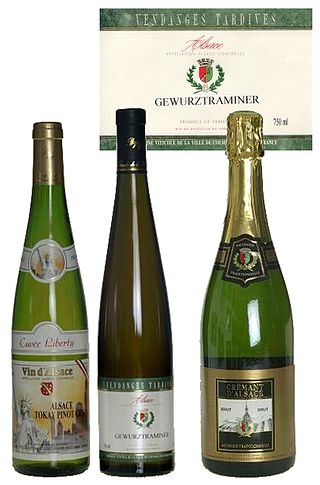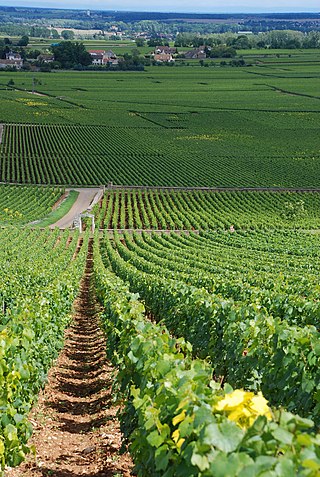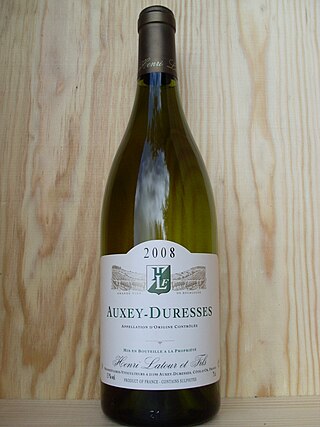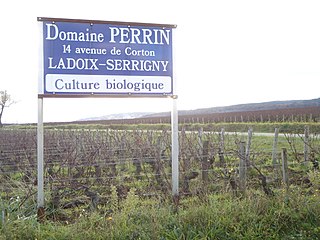Chapelle-Chambertin is an Appellation d'origine contrôlée (AOC) and Grand Cru vineyard for red wine in the Côte de Nuits subregion of Burgundy, with Pinot noir as the main grape variety. It is located in the southern part of the commune of Gevrey-Chambertin and on the lower hillside east of Chambertin-Clos de Bèze and north of Griotte-Chambertin. The AOC was created in 1937.
Griotte-Chambertin is an Appellation d'origine contrôlée (AOC) and Grand Cru vineyard for red wine in the Côte de Nuits subregion of Burgundy, with Pinot noir as the main grape variety. Griotte-Chambertin is located within the commune of Gevrey-Chambertin. It is situated on the lower part of the hillside among the other "Chambertin", on the eastern (downhill) side of the Route des Grands Crus. It borders on Chapelle-Chambertin in the north, Charmes-Chambertin in the south, Chambertin itself in the west, and village-level Gevrey-Chambertin vineyards in the east.

Clos des Lambrays is an Appellation d'origine contrôlée (AOC) and Grand Cru vineyard for red wine in the Côte de Nuits subregion of Burgundy, with Pinot noir as the main grape variety. It is situated in the commune of Morey-Saint-Denis in the Côte-d'Or département, and is located immediately to the southwest of the village Morey-Saint-Denis. The Clos part of its name refers to a wall-enclosed vineyard. Clos des Lambrays was elevated from premier cru to grand cru status in 1981, which meant that it was created as a separate AOC.

Santenay wine is produced in the communes of Santenay and Remigny in Côte de Beaune of Burgundy. The Appellation d'origine contrôlée (AOC) Santenay may be used for red and white wine with respectively Pinot noir and Chardonnay as the main grape variety. The production consists of almost 85% red wine, and a little over 15% of white wine. There are no Grand Cru vineyards within the Santenay AOC.

Mercurey wine is produced in the communes of Mercurey and Saint-Martin-sous-Montaigu in the Côte Chalonnaise subregion of Burgundy. The Appellation d'origine contrôlée (AOC) Mercurey may be used for red and white wine with respectively Pinot noir and Chardonnay as the main grape variety. The production of red wine dominates, with almost 80 per cent.

The wine region of Alsace produces wines under three different Appellations d'Origine Contrôlées (AOCs): Alsace AOC for white, rosé and red wines, Alsace Grand Cru AOC for white wines from certain classified vineyards and Crémant d'Alsace AOC for sparkling wines. This region is the only French wine region allowed to label its wines based on variety.

Chambolle-Musigny wine is produced in the village of Chambolle-Musigny in Côte de Nuits of Burgundy. The Appellation d'origine contrôlée (AOC) Chambolle-Musigny may only be used for red wine with Pinot noir as the main grape. There are 25 Premier Cru vineyards in Chambolle-Musigny, and two Grand Cru vineyards: Musigny and Bonnes Mares. The AOC was created in 1936.

Meursault wine is produced in the commune of Meursault in Côte de Beaune of Burgundy. The Appellation d'origine contrôlée (AOC) Meursault may be used for white wine and red with respectively Chardonnay and Pinot noir as the main grape varieties. The production of white Meursault dominates, with around 98 per cent. There are no Grand Cru vineyards within Meursault, but several highly regarded Premier Cru vineyards.

Puligny-Montrachet wine is produced in the commune of Puligny-Montrachet in Côte de Beaune of Burgundy. The Appellation d'origine contrôlée (AOC) Puligny-Montrachet may be used for white wine and red with respectively Chardonnay and Pinot noir as the main grape variety. However, almost only white Puligny-Montrachet is produced, at around 99.5 per cent of the total production. There are four Grand Cru vineyards within Puligny-Montrachet, with Montrachet the most well-known, and 17 Premier Cru vineyards.

Pommard wine is produced in the commune of Pommard in Côte de Beaune of Burgundy. The Appellation d'origine contrôlée (AOC) Pommard is only used for red wine with Pinot noir as the main grape variety. There are no Grand Cru vineyards within Pommard, but several highly regarded Premier Cru vineyards. The AOC was created in 1937.

Maranges wine is produced in the communes of Cheilly-lès-Maranges, Dezize-lès-Maranges and Sampigny-lès-Maranges in Côte de Beaune of Burgundy. The Appellation d'origine contrôlée (AOC) Maranges may be used for red and white wine with respectively Pinot noir and Chardonnay as the main grape variety. The production consists of around 95% red wine and 5% white wine. There are no Grand Cru vineyards within the Maranges AOC.

Auxey-Duresses wine is produced in the commune of Auxey-Duresses in Côte de Beaune of Burgundy. The Appellation d'origine contrôlée (AOC) Auxey-Duresses may be used for red and white wine with respectively Pinot noir and Chardonnay as the main grape variety. The production consists of around two-thirds red wine, and one-third white wine. There are no Grand Cru vineyards within Auxey-Duresses. The AOC Auxey-Duresses was created in 1970. Before the introduction of the appellation system in the 1930s, wines from this village were probably sold under the names of the more famous neighbors Volnay and Meursault. Later, the wines have been sold as Côte de Beaune-Villages, but it has progressively become more common to actually use the Auxey-Duresses AOC for the wines.

Monthélie wine is produced in the commune of Monthelie in Côte de Beaune of Burgundy. The Appellation d'origine contrôlée (AOC) Monthélie may be used for red and white wine with respectively Pinot noir and Chardonnay as the main grape variety. The production consists of more than 85% red wine, and less than 15% white wine. There are no Grand Cru vineyards within Monthelie.

Aloxe-Corton wine is produced in the communes of Aloxe-Corton and Ladoix-Serrigny in Côte de Beaune of Burgundy. The appellation d'origine contrôlée (AOC) Aloxe-Corton may be used for red and white wine with respectively Pinot noir and Chardonnay as the main grape variety. The production consists of almost only red wine, around 98 per cent, and only around two per cent white wine. The southern and eastern side of the Corton hill is located in the commune of Aloxe-Corton, including vineyards of all three Grand Cru AOCs of the hill; Corton, Corton-Charlemagne and Charlemagne, and its northeastern part in the commune of Ladoix-Serrigny. The major part of the Corton hill is located within Aloxe-Corton. The AOC was created in 1938.

Ladoix wine is produced in the commune of Ladoix-Serrigny in Côte de Beaune of Burgundy, France. The Appellation d'origine contrôlée (AOC) Ladoix may be used for red and white wine with respectively Pinot noir and Chardonnay as the main grape variety. The production consists of around three-quarter red wine, and around one-quarter white wine. The northeastern part of the Corton hill is located in the commune of Ladoix-Serrigny, including vineyards of two of the three Grand Cru AOCs of the hill, Corton and Corton-Charlemagne. Some of the Premier Cru vineyards of Ladoix-Serrigny are part of the Aloxe-Corton AOC of the neighbouring village rather than of Ladoix AOC, and vinified and sold as Aloxe-Corton Premier Cru.

Savigny-lès-Beaune wine is produced in the commune of Savigny-lès-Beaune in Côte de Beaune of Burgundy. The Appellation d'origine contrôlée (AOC) Savigny-lès-Beaune may be used for red and white wine with respectively Pinot noir and Chardonnay as the main grape variety. The name of the appellation is sometimes written simply as Savigny, without the -lès-Beaune suffix. The production consists of slightly over 85 per cent red wine, and slightly less than 15 per cent white wine. There are no Grand Cru vineyards within Savigny-lès-Beaune.

Nuits-Saint-Georges wine is produced in the communes of Nuits-Saint-Georges and Premeaux-Prissey in the Côte de Nuits subregion of Burgundy. The Appellation d'origine contrôlée (AOC) Nuits-Saint-Georges may be used for red and white wine with respectively Pinot noir and Chardonnay as the main grape variety. The name of the appellation is sometimes written simply as Nuits, without the Saint-Georges part. The word "Nuits" has nothing to do with "nighttime" but comes from the Latin for walnuts, Nutium. The production of red wine dominates greatly, with around 97 per cent, and only around three per cent white wine. There are no Grand Cru vineyards within Nuits-Saint-Georges.

Morey-Saint-Denis wine is produced in the commune of Morey-Saint-Denis in the Côte de Nuits subregion of Burgundy. The Appellation d'origine contrôlée (AOC) Morey-Saint-Denis may be used for red and white wine with respectively Pinot noir and Chardonnay as the main grape variety. The production of red wine dominates greatly, with around 96 per cent, and only around four per cent white wine. There are five Grand Cru vineyards with the commune: Clos de Tart, Clos des Lambrays, Clos Saint-Denis, Clos de la Roche and Bonnes Mares, which is shared with Chambolle-Musigny.

Fixin wine is produced in the communes of Fixin and Brochon in the Côte de Nuits subregion of Burgundy. The Appellation d'origine contrôlée (AOC) Fixin may be used for red and white wine with respectively Pinot noir and Chardonnay as the main grape variety. The production of red wine dominates greatly, with around 96 per cent, and only around four per cent white wine. There are no Grand Cru vineyards with these communes.

Among the countries of North Africa, Morocco is considered to have the best natural potential for producing quality wines, due to its high mountains and the cooling influence of the Atlantic, as these factors offset the risk of having too hot vineyards. An important exporter of wine in the colonial era between 1912 and 1955, the Moroccan wine industry is experiencing a revival and expansion since the 1990s due to influx of foreign investments.

























